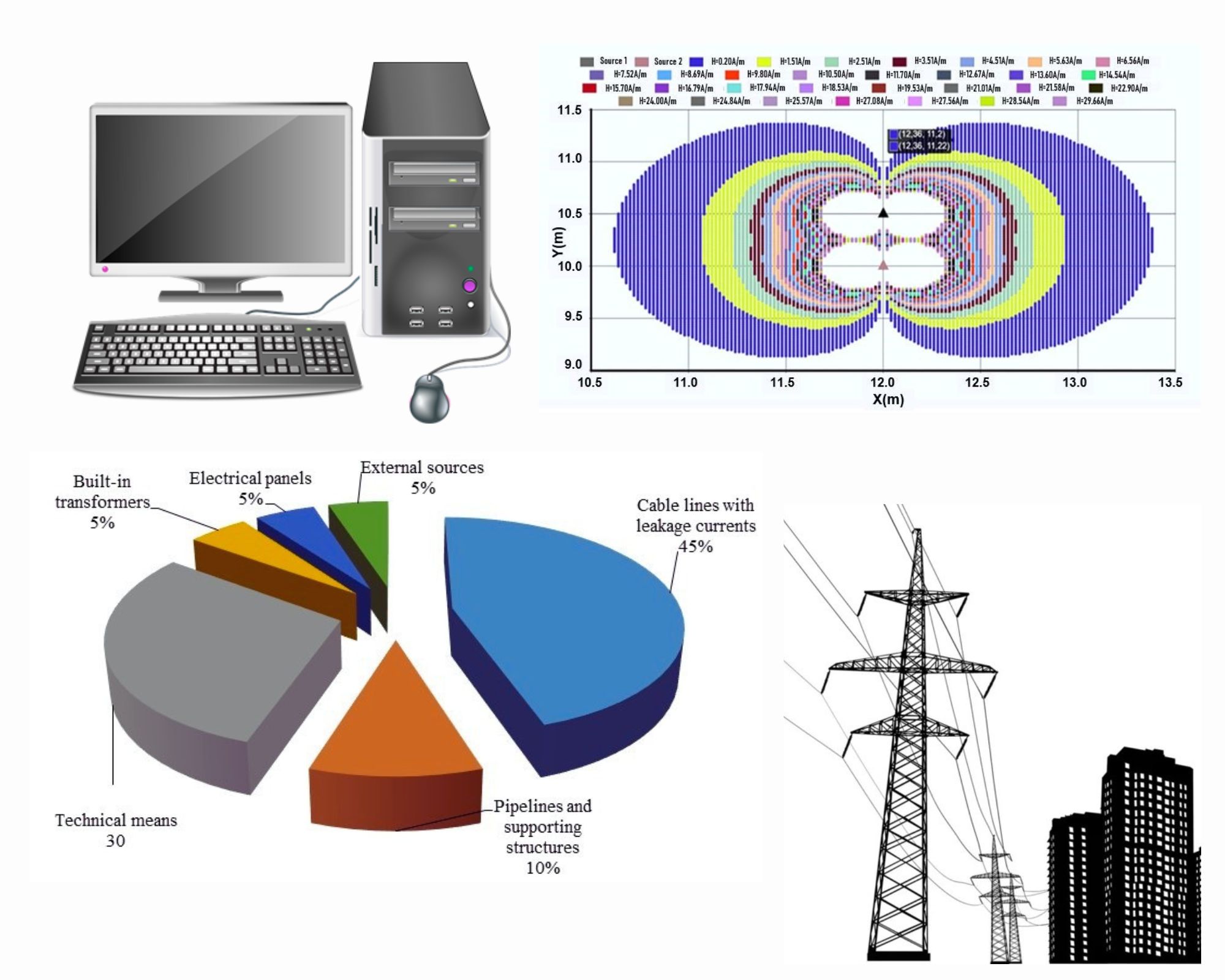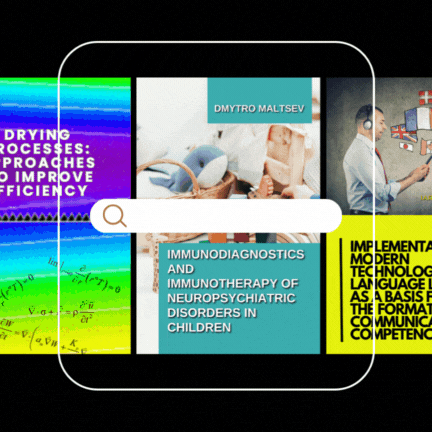Development of models of the electromagnetic environment in buildings and urbanized areas
DOI:
https://doi.org/10.15587/1729-4061.2022.268439Keywords:
electromagnetic field, electromagnetic situation, industrial frequency, power line, personal computerAbstract
A set of measures and means to control the electromagnetic situation of the environment in the territories of urban development, in buildings and individual premises has been substantiated and developed. The simulation tools show the ability to rationalize the parameters of overhead lines with voltages of 220 kV and below, which will reduce the electromagnetic load in the territories. Modeling the propagation of fields from underground high-voltage lines has established that the values of magnetic fields compared to overhead lines are lower up to 30 times. Models of propagation of electromagnetic fields of very high and ultrahigh frequency were built. Sources of electromagnetic fields of non-production origin in industrial buildings have been investigated. Uncompensated currents in power networks with nonlinear electric consumers generate magnetic fields by induction of 0.35−1.20 μT, which exceeds the maximum permissible levels of operation of computer equipment. Leakage currents on grounded metal structures generate magnetic fields with 1.52−6.75 μT.
Simulation of the propagation of electric and magnetic fields of components of personal computers of controlled ranges according to the MPRII standard was carried out. Models of propagation of the magnetic field of industrial frequency around electric motors and generators with their cross sections were built. On the basis of such models, design schemes for placing equipment in production areas are selected or places of safe stay and movement of personnel are selected. The expediency of using shielding to reduce field levels to safe values due to coating surfaces with liquid protective mixtures was shown. Metal-containing composition based on water-dispersion paint makes it possible to reduce the level of magnetic field of industrial frequency by 2.5−2.6 times, electric field by 1.6−1.7 times, electromagnetic field of industrial frequency – by 1.2−1.3 times.
References
- Directive 2013/35/EU of the European Parliament and of the Council of 26 June 2013 on the minimum health and safety requirements regarding the exposure of workers to the risks arising from physical agents (electromagnetic fields) (20th individual Directive within the meaning of Article 16(1) of Directive 89/391/EEC) and repealing Directive 2004/40/EC. Available at: https://eur-lex.europa.eu/eli/dir/2013/35/oj
- Directives. Directive 2014/52/EU of the European parliament and of the council of 16 April 2014 amending Directive 2011/92/EU on the assessment of the effects of certain public and private projects on the environment (Text with EEA relevance). Available at: http://extwprlegs1.fao.org/docs/pdf/eur133116.pdf
- Pelevin, D. Ye. (2014). The methods of reducing of the magnetic fields of overhead power lines outside security zones. Tekhnichna elektrodynamika, 5, 14–16. Available at: http://dspace.nbuv.gov.ua/handle/123456789/135627
- Grinchenko, V. S. (2018). Mitigation of three-phase power line magnetic field by grid electromagnetic shield. Tekhnichna Elektrodynamika, 2018 (4), 29–32. doi: https://doi.org/10.15407/techned2018.04.029
- Rozov, V. Yu., Reutskyi, S. Yu., Pelevin, D. Ye., Kundius, K. D. (2022). Approximate method for calculating the magnetic field of 330-750 kV high-voltage power line in maintenance area under voltage. Electrical Engineering & Electromechanics, 5, 71–77. doi: https://doi.org/10.20998/2074-272x.2022.5.12
- Kuznetsov, B. I., Nikitina, T. B., Bovdui, I. V., Voloshko, O. V., Kolomiets, V. V., Kobylianskyi, B. B. (2022). Comparison of the effectiveness of thriple-loop and double-loop systems of active shielding of a magnetic field in a multi-storey old buildings. Electrical Engineering & Electromechanics, 3, 21–27. doi: https://doi.org/10.20998/2074-272x.2022.3.04
- Rozov, V. Yu., Pelevin, D. Ye., Pielievina, K. D. (2017). External magnetic field of urban transformer substations and methods of its normalization. Electrical Engineering & Electromechanics, 5, 60–66. doi: https://doi.org/10.20998/2074-272x.2017.5.10
- Koppel, T., Ahonen, M., Carlberg, M., Hedendahl, L., Hardell, L. (2019). Radiofrequency radiation from nearby mobile phone base stations‑a case comparison of one low and one high exposure apartment. Oncology Letters, 18 (5). doi: https://doi.org/10.3892/ol.2019.10899
- Mordachev, V. I., Svistunov, A. S. (2013). Required and sufficient level of GSM base stations electromagnetic radiation power. Doklady BGUIR, 7, 44–50.
- Sukach, S., Riznik, D., Zachepa, N., Chenchevoy, V. (2020). Normalization of the Magnetic Fields of Electrical Equipment in Case of Unauthorized Influence on Critical Information Infrastructure Facilities. Soft Target Protection, 337–349. doi: https://doi.org/10.1007/978-94-024-1755-5_28
- Chen, F., Liu, Y., Wang, P. (2015). Study on the Propagation Characteristics of Radio Wave for Indoor Non-Line-of-Sight. Journal of Computer and Communications, 03 (03), 40–43. doi: https://doi.org/10.4236/jcc.2015.33007
- Singh, J. (2015). Computer Generated Energy Effects on Users and Shielding Interference. International Journal of Innovative Research in Computer and Communication Engineering, 3, 10022–10027.
- Glyva, V., Kasatkina, N., Levchenko, L., Tykhenko, O., Nazarenko, V., Burdeina, N. et al. (2022). Determining the dynamics of electromagnetic fields, air ionization, low-frequency sound and their normalization in premises for computer equipment. Eastern-European Journal of Enterprise Technologies, 3 (10 (117)), 47–55. doi: https://doi.org/10.15587/1729-4061.2022.258939
- Bolibrukh, B., Glyva, V., Kasatkina, N., Levchenko, L., Tykhenko, O., Panova, O. et al. (2022). Monitoring and management ion concentrations in the air of industrial and public premises. Eastern-European Journal of Enterprise Technologies, 1 (10 (115)), 24–30. doi: https://doi.org/10.15587/1729-4061.2022.253110
- Tudose, I. V., Mouratis, K., Ionescu, O. N., Romanitan, C., Pachiu, C., Popescu, M. et al. (2022). Novel Water-Based Paints for Composite Materials Used in Electromagnetic Shielding Applications. Nanomaterials, 12 (3), 487. doi: https://doi.org/10.3390/nano12030487
- Kochetov, G., Prikhna, T., Samchenko, D., Prysiazhna, O., Monastyrov, M., Mosshchil, V., Mamalis, A. (2021). Resource efficient ferritizatio treatment for concentrated wastewater from electroplating production with aftertreatment by nanosorbents. Nanotechnology Perceptions, 17 (1), 9–18. doi: https://doi.org/10.4024/n22ko20a.ntp.17.01
- Kochetov, G., Kovalchuk, O., Samchenko, D. (2020). Development of technology of utilization of products of ferritization processing of galvanic waste in the composition of alkaline cements. Eastern-European Journal of Enterprise Technologies, 5 (10 (107)), 6–13. doi: https://doi.org/10.15587/1729-4061.2020.215129
- Khodakovskyi, O., Levchenko, L., Kolumbet, V., Kozachuk, A., Kuzhavskyi, D. (2021). Calculation apparatus for modeling the distribution of electromagnetic fields of different sources. Advanced Information Systems, 5 (1), 34–38. doi: https://doi.org/10.20998/2522-9052.2021.1.04
- Sayenko, Y. (2019). Kompensacja mocy biernej w sieciach elektrycznych ze źródłami interharmonicznych. PRZEGLĄD ELEKTROTECHNICZNY, 1 (3), 43–46. doi: https://doi.org/10.15199/48.2019.03.10
- Getman, A. (2018). Development of the technique for improving the structure of a magnetic field in the aperture of a quadrupole electromagnet with a superconducting winding. Eastern-European Journal of Enterprise Technologies, 5 (5 (95)), 6–12. doi: https://doi.org/10.15587/1729-4061.2018.142163

Downloads
Published
How to Cite
Issue
Section
License
Copyright (c) 2022 Larysa Levchenko, Nataliia Ausheva, Nataliia Burdeina, Iryna Aznaurian, Yana Biruk, Natalia Kasatkina, Iryna Matvieieva, Vasyl Nazarenko, Kyrylo Nikolaiev, Oksana Tykhenko

This work is licensed under a Creative Commons Attribution 4.0 International License.
The consolidation and conditions for the transfer of copyright (identification of authorship) is carried out in the License Agreement. In particular, the authors reserve the right to the authorship of their manuscript and transfer the first publication of this work to the journal under the terms of the Creative Commons CC BY license. At the same time, they have the right to conclude on their own additional agreements concerning the non-exclusive distribution of the work in the form in which it was published by this journal, but provided that the link to the first publication of the article in this journal is preserved.
A license agreement is a document in which the author warrants that he/she owns all copyright for the work (manuscript, article, etc.).
The authors, signing the License Agreement with TECHNOLOGY CENTER PC, have all rights to the further use of their work, provided that they link to our edition in which the work was published.
According to the terms of the License Agreement, the Publisher TECHNOLOGY CENTER PC does not take away your copyrights and receives permission from the authors to use and dissemination of the publication through the world's scientific resources (own electronic resources, scientometric databases, repositories, libraries, etc.).
In the absence of a signed License Agreement or in the absence of this agreement of identifiers allowing to identify the identity of the author, the editors have no right to work with the manuscript.
It is important to remember that there is another type of agreement between authors and publishers – when copyright is transferred from the authors to the publisher. In this case, the authors lose ownership of their work and may not use it in any way.









